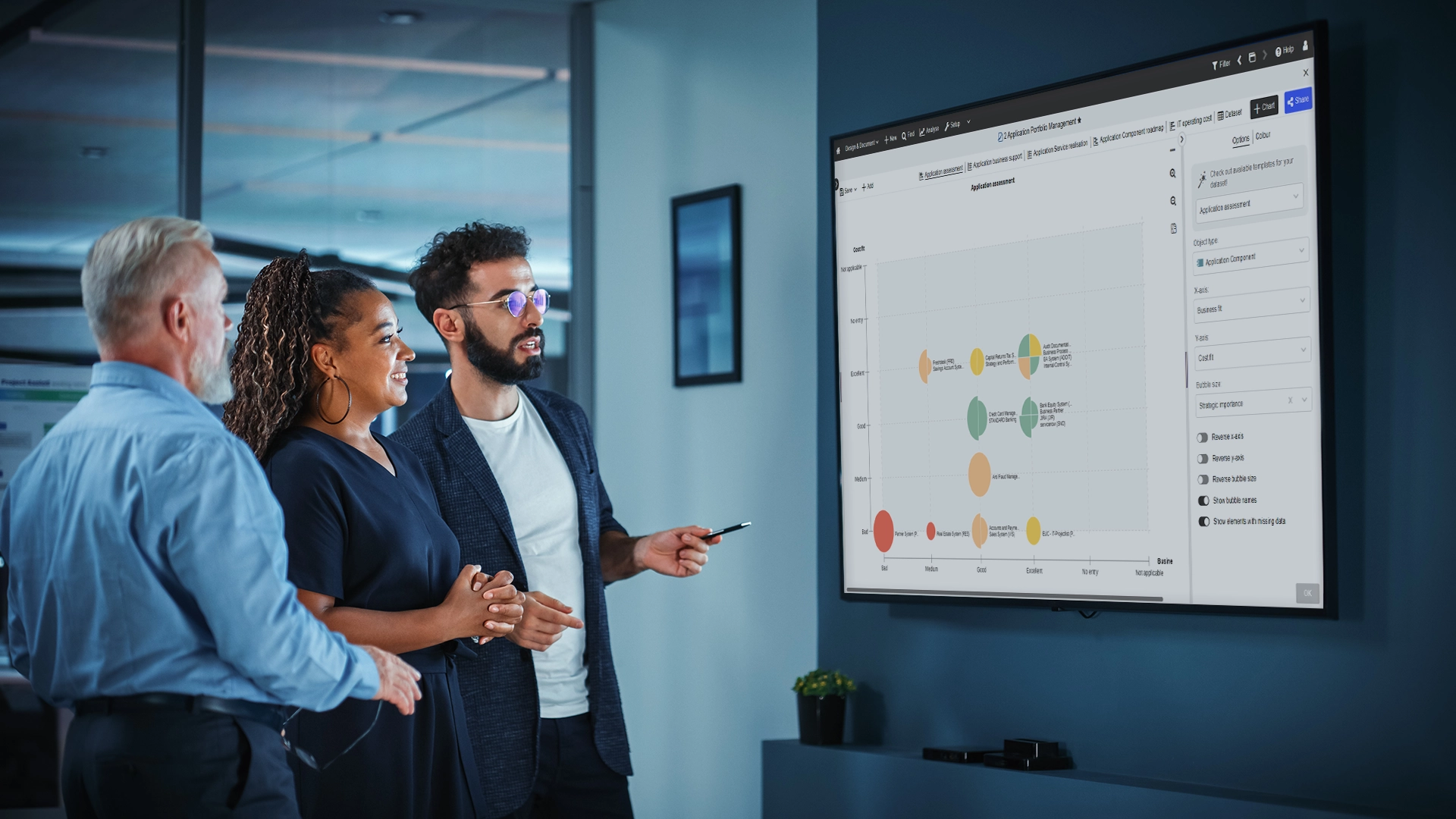Introduction
Sustainability has been recognized as one of the major global concerns since the Brudtland report in 1987 and further reinforced in 2015 by 17 United Nations Sustainability Development Goals (UNSDGs) 2030.
It contains goals that each of us would sign, like “substantially reduce waste generation through prevention, reduction, recycling and reuse“. And it’s up to everyone, not only individuals, but also, and more importantly, companies, to achieve these goals in order to provide a livable tomorrow for future generations.
Now, you may wonder why this is a topic for our EA blog? Well, Enterprise Architecture is a key asset when it comes to driving successful and continuous enterprise change, supporting high-level business transformation, and enabling execution of strategic plans. To that end, EA is the perfect starting point for laying a solid foundation for your sustainability strategy.
If you want to know how an EA-based approach can help companies achieve their sustainability goals, keep reading this blog post.
Why is sustainability quintessential for businesses?
Sustainability is not only crucial for us humans, but companies can also benefit from integrating sustainability into their business models:
1. Integrating sustainability strategies improves operational efficiency, mitigates risks, and reduces costs. Sustainable business models also increase growth by creating business value and gaining competitive advantage.
2. Today’s leaders must lead from the future. As the expectations on corporate responsibility increase, and as transparency becomes more prevalent, companies must recognize the need to act on sustainability.
Sustainability Business Implementation Methods
Specific business models can be described in two terms, derived from the concept of sustainability:
- CSR or Corporate Social Responsibility is a general sustainability framework used by companies, through which they integrate social and environmental concepts into their business operations.
- ESG combines Environmental, Social and Governance aspects to evaluate a company’s long term sustainability performance. A measurable sustainability assessment, popular with investors.
If you would like to delve deeper into the topic of ESG, we recommend the following blog post.
Why do companies struggle to integrate sustainability?
- One of the biggest bottlenecks when it comes to sustainability is the false sustainability claims or “Green Washing”, that is, committing publicly to sustainability goals and initiatives but not delivering.
- Secondly, even though a considerable number of enterprises are willing to embrace sustainability initiatives, successful implementation requires a holistic approach starting with the evaluation and measurement of the organization’s environmental performance.
- Furthermore, handling such a complex endeavor requires a structured approach. And this is where Enterprise Architecture comes into play.
An EA-based approach to achieving sustainability goals
- To understand why EA could be your chosen means of tackling sustainability topics, let’s take a closer look at the essence of EA.
- Enterprise Architecture provides a holistic view of the organization. Enterprise architects have well-developed methodologies and comprehensive access to the IT and business portfolio data. Hence, it brings forth an ideal position to translate business strategy into execution.
- Enterprise architecture modelling languages enable enterprise architects to portray an enterprise’s business environment in an EA suite, like our industry-wide acknowledged ADOIT, as well as all its related organizational concerns and issues. An example of a well-established EA modelling language is ArchiMate. It is a good starting point as it can describe all levels of the company from strategy to implementation. If you are not familiar with ArchiMate, be sure to check out our free ArchiMate poster that provides an overview and explanation of all ArchiMate symbols.

By using EA frameworks, like the ArchiMate Core Framework, as a foundation, sustainability related goals can be mapped to all levels of the organization.
Strategy
Without being fully integrated into an organization’s wider strategy, there is a big risk of the fore-mentioned “Greenwashing”. To avoid this, sustainable frameworks like UNSDGs can be consolidated with the strategic goals in order to devise an ESG strategy tailored to each organizational unit.
For instance, for a manufacturing company an overall strategy driver could be UNSDGs goal number 12 “Ensure sustainable consumption and production patterns”. Based on the goals, the company course of action and objectives can include:
- Determining the focus to achieving a sustainable management and efficient use of natural resources like domestic material consumption, for instance.
- Sustainably reduce waste generation through prevention, reduction, recycling and reuse.
In this context, our blog post on strategic roadmapping is a great read with concrete tips on how to turn your sustainability vision into actionable plans.
Business
Aligning business with the sustainability objective and strategy is the key to successful implementation. Whether it’s organizational HR policies, or procurement network, multitude organizational processes need to be assessed for their ability to meet ESG goals. Taking a look at procurement, for example: How do the supplier’s ESG profiles fit with your ESG goals? What is the impact of supply chain on carbon footprint, is the supplier practice sustainable sourcing?
Application
Within the domain of Application, for example, a simple thought-provoking idea could be questioning how applications are programmed. Algorithms and images used all impact the amount of data that is transmitted over the internet. The amount of data that we transfer over the internet networks, or through the air wirelessly, all have energy impacts. Did you know a png image file uses 50% less energy than a jpeg?
If you want to know how to best build and manage a sustainable and future-proof application portfolio, have a look at our blog post on application portfolio management.
Technology
To transform a conventional business model into a sustainable business, a sustainable framework is needed. It must contain technological solutions that enable environmental, social and governance outcomes.
- Environmental technologies mitigate and adapt risks in the natural world.
- Social technologies improve human well-being and prosperity.
- Governance technologies strengthen law and business conduct.
If you are interested in how you can derive a robust and sustainable technology strategy, check out our technology radar blog post.
Physical
All the physical elements like equipment, facility, distribution network and materials also require a sustainable approach to transform an organization. For example, if a production-based company goal is to improve responsible consumption and production, UNSGDs goal number 12, then the company must investigate and analyse which types (and how many) of machinery, materials and resources are being utilized and where there’s space for improvement.
Implementation and Migration
Sustainability must be given a higher priority in the implementation of projects. During implementation, it must be ensured that the chosen solutions are sustainable – since it’s more difficult to incorporate sustainability retrospectively. In the initial stages an organization decides what to do, this stage details how to do it and defines the project.
How to get started with an EA-based approach to sustainability?
Knowing the how and what to implement in terms of ESG can be complex and confusing. No matter which specific United Nations Sustainable Development Goal you want to achieve, change cannot start exclusively in the executive floor. The following simple yet robust approach is suggested:
- Formulate a team of sustainability enthusiasts who are equally aware of UNSGDs to make it transparent. The team should have effective communication with the management board.
- Try to target low hanging fruits first to avoid high-cost and low benefits.
- Anchor your ESG goals in your EA target architectures.
Summary
More than ever, businesses are coming under scrutiny for their environmental, social, and governance (ESG) practices. Therefore, to maintain their competitive advantage, companies must transform their business models for sustainability. Focusing on every component of business, EA framework allows the organization to go from vision to implementation at all organizational levels and areas.
If you would like to learn more about how to align your sustainability efforts with your EA, please don’t hesitate to contact us. Our EA experts will be happy to help you develop a concept for implementing your sustainable strategy.
And if you’re looking for a powerful, yet simple EA tool to ease and support your ESG strategy implementation, sign-up for our free EA suite ADOIT:Community Edition and get your sustainability initiatives under way today!





